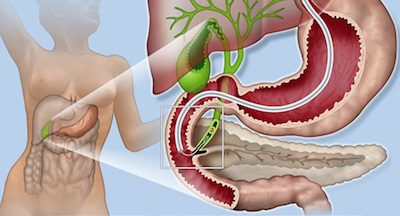 What?
What?
Endoscopic Retrograde Cholangio Pancreatography (ERCP) is a method for getting into the bile duct and pancreas though the mouth. The ERCP procedure was introduced over 40 years ago. In Malaysia, the ERCP was only available in 1990’. ERCP is a highly specialized procedure which requires a lot of experience and skill, in which the gastroenterologists and hepatobiliary surgeons are trained in this field.
When?
ERCP used to be practised as a diagnostic investigation during the initial years. Our present-day medicine offers many safer investigations for diagnosing diseases within the biliary tract, such as a computed tomography (CT) scan, a magnetic retrograde cholangiopancreatography (MRCP) scan, or an endoscopic ultrasound (EUS). All of these investigations are less invasive than an ERCP procedure.
Nowadays, the ERCP procedure is mainly used for therapeutic purpose. By doing the ERCP, the obstructive jaundice could be relieved by stone extraction (for common bile duct stone disease), or by stenting (for malignancies e.g. pancreatic cancer, and cholangiocarcinoma); the biliary strictures e.g. primary sclerosing cholangitis, and anastomotic strictures after liver transplantation could be dilated; and, the endoscopic sphincterotomy of the biliary or the pancreatic duct sphincter could be performed.
How?
Many university hospitals, general hospitals, and tertiary hospitals in Malaysia provide ERCP service. And this procedure is preferable to be performed as inpatient, under intravenous sedation. This procedure takes about 30-90 minutes. You need to be fasted for at least 6 hours prior to make sure you have an empty stomach. Be sure to tell the doctor if you are taking warfarin, blood thinners, anti-platelet medication, or any diabetic medicine, as well as if you have any allergies to medications or to intravenous contrast material or dye. Also, do inform your doctor if you have heart or lung conditions or other major illnesses which might prevent or impact the decision to proceed the ERCP. You might be given rectal medication (NSAIDs) or intravenous antibiotic prior the procedure to reduce the risk of complications.
There are few drawbacks to ERCP which will be explained and understood before you agree to undergo the procedure. ERCP is not perfect. Working on the pancreas and bile duct can cause complications, even in the best hands. Occasionally, important lesions may not be seen, and treatment attempts may be unsuccessful.
The success rate in performing ERCP varies from 70% to 85%. The most common complication is pancreatitis (swelling and inflammation of the pancreas), which could be 5%, and results in the need to stay in hospital for pain medications and IV fluids. Other complications could be perforation of intestine or biliary duct, bleeding, infections, depressed breathing, and drug reactions.
You will lie in a comfortable position on an X-ray table. Then, your throat will be sprayed with a local anesthetic to numb your throat, followed by intravenous medication to help you relax before the procedure. A bendable, lighted tube (endoscope) about the thickness of your index finger will be gently passed through your mouth, down your food pipe, and into your stomach and duodenum (the first part of the small intestine). The goal is to access the papilla of Vater, a small nipple in the duodenum. This papilla is the drainage hole for the bile and pancreatic duct, which bring digestive juices from the liver, gallbladder and pancreas. The doctor injects contrast dyes through the papilla into the ducts and takes X-rays to show lesions such as stones, strictures or mass lesions. During the procedure, you may feel some bloating due to the air inserted. As the dye is injected, you may also feel some discomfort.
You will be monitored in the ward for few hours until the effects of the sedatives have worn off, and if no complication happens. Your throat may be sore for a day or two. You may be allowed to drink followed by some food and to take your routine medicine few hours later.
Your doctor will inform your procedure findings on the day of the procedure. Biopsy results take several days to return, and the follow up arrangements should be made.
Dr. Chieng Jin Yu is a consultant Gastroenterologist & Hepatologist and a medical lecturer at Universiti Putra Malaysia.
References:
- American Society for Gastrointestinal Endoscopy (ASGE) – Understanding ERCP
- Chernecky CC, Berger BJ (2008). Laboratory Tests and Diagnostic Procedures, 5th ed. St. Louis: Saunders.
[This article belongs to The Malaysian Medical Gazette. Any republication (online or offline) without written permission from The Malaysian Medical Gazette is prohibited.]
